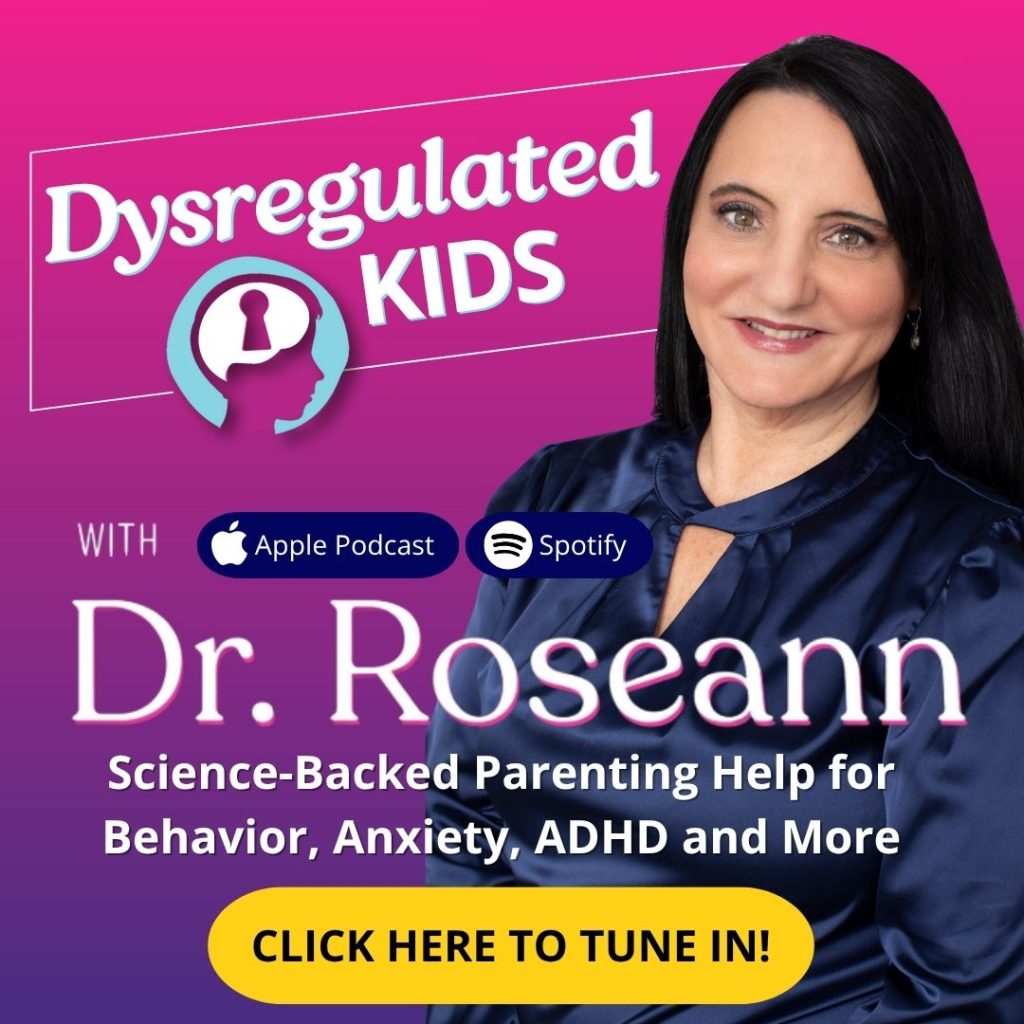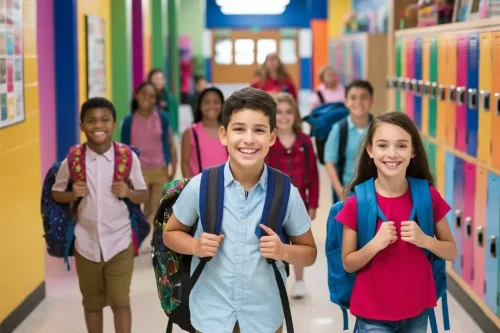Estimated reading time: 9 minutes
One clear guide to help you understand autism + ADHD together. And what actually helps at home and school.
If your child’s behavior feels confusing or “all over the place,” you’re not alone. Many kids show traits of both autism and ADHD.
Parents ask me every day, “What is AuDHD?” As both a clinician and a mom, I know how confusing these mixed signals can feel.
In this warm, practical guide, I explain what it means, why you’re hearing the term more, and the calm-first steps that make life easier for your child—and you.
In this article, you’ll learn:
- What AuDHD is
- How it’s assessed
- Everyday signs
- School supports
- And a step-by-step, regulation-first plan you can start today
What Is AuDHD?
AuDHD describes co-occurring autism and ADHD in the same person.
Since DSM-5 allowed both diagnoses in 2013, more kids are accurately identified instead of being forced into an either/or box.
Research shows real overlap in traits. And even shared genetic influences—between autism and ADHD (Rommelse et al., 2021).
“Family and twin studies show ADHD and autism share genetic influences. Treat what’s shared and what’s distinct.” — Marieke Rommelse, PhD (Rommelse et al., 2021)
This isn’t a fad. It’s better recognition—and better support—of kids who need both approaches.
How to Tell “Won’t” From “Can’t” With AuDHD Behavior
Capacity changes with regulation. A child can look “refusal-based” when their nervous system is actually overloaded.
Watch for “can’t” clues:
- Sudden shutdowns with noise, lights, or clothing textures.
- “Task start” paralysis, even for simple steps.
- Meltdowns after multiple instructions or fast transitions.
Parent snapshot:
Maddie, mom of a 10-year-old, thought her son “wouldn’t” do homework. We added a 3-step visual card and a two-minute wiggle break. He started on time and finished in 20 minutes.
Takeaway:
Behavior is communication; reduce load, and skills show up.
Quick script: “Let’s pause, breathe together, and start with just step one.”
Underline this mindset: Regulate. Connect. Correct.™
Day-To-Day Signs to Look for at Home and School
AuDHD blends autistic social/communication differences and sensory needs with ADHD patterns of inattention, impulsivity, and hyperactivity. Population data confirm frequent co-occurrence (Danielson et al., 2018).
Home Patterns
- Sensory: strong reactions to sound, light, textures, or foods.
- Routines: trouble shifting; “one more minute” loops; bedtime battles.
- Emotions: fast “0→100” reactions; shame after outbursts.
School Patterns
- Executive function: loses papers, slow to start, stops mid-task.
- Social: literal communication, misses “hidden rules,” masks then crashes.
- Attention profile: hyperfocus on interests, distractible on non-preferred work.
Let’s look at how these traits often show up in daily life.

How Is AuDHD Diagnosed
A thorough evaluation should look beyond labels to function, context, and regulation. Use multiple sources—home, school, and direct observation.
Many children qualify for both diagnoses when the criteria are carefully reviewed (Danielson et al., 2018).
Ask Your Evaluator
- Detailed developmental history + parent/teacher input.
- Observation of social reciprocity, flexibility, and coping.
- Executive function and learning measures.
- A sensory profile to identify triggers and supports.
- Screening of sleep, medical, vision/hearing, and anxiety.
| Assessment Component | What It Looks For | Why It Matters |
|---|---|---|
| History & interviews | Early social/communication, restricted interests, attention patternsEstablishes onset and context | Establishes onset and context |
| Standardized scales (home/school) | Autism, ADHD, and EF indicators | Confirms cross-setting patterns |
| Direct observation | Social reciprocity, flexibility, masking | Captures real-world functioning |
| Cognitive/academic testing | Working memory, processing speed, decoding/writing | Guides learning supports |
| Sensory profile | Triggers, thresholds, seeking/avoidance | Targets accommodations |
| Health/sleep review | Factors that amplify dysregulation | Treats root contributors |
“Population data tell us many kids meet criteria for both—so we should design supports that reflect that reality.” — Melissa Danielson, MSPH (Danielson et al., 2018)
What Helps First at Home—Before Behavior Plans?
Start with Regulation First Parenting™: Regulate → Connect → Correct. Calm brains learn. Dysregulated brains don’t.
Try this today:
- Co-regulate: slow exhale; shoulder-to-shoulder; soft voice.
- Sensory menu: weighted lap pad, movement bursts, chewy snacks, dim lights.
- Visuals > words: 3-step checklist; timer for “start” and “wrap.”
- One change at a time: fix bedtime routine first; then homework setup.
Calm the brain first; everything follows.
Parent snapshot:
Marco needed motion. A five-minute trampoline break before homework cut meltdowns in a week.
Takeaway:
Sensory input before demand prevents overload.

What Actually Works at School Without a Fight
You don’t need 20 accommodations. You need the right ones.
Ask for:
- Prime the brain: movement or sensory break before
- Chunk tasks: 3 problems → check-in → next chunk.
- Alternate output: oral responses, graphic organizers, typing.
- Predictable routine: visual schedule, transition warnings.
- Low-stim space: headphones, fewer visual distractions.
Parent snapshot:
Ava, age 8, went from daily nurse visits to none after adding morning movement, a quiet table, and visual directions. T
Takeaway:
Lower the load, unlock learning.
Evidence-Based Treatments and How to Build a Plan
There’s no one-size protocol. There is good science to guide your choices.
Evidence Highlights
- Skill + parent-supported programs can improve attention and real-life function in ADHD (Chacko, Kofler, & Jarrett, 2014).
- Genetic overlap reminds us to treat shared and distinct needs in AuDHD (Rommelse et al., 2021).
- Population studies show many kids meet criteria for both (Danielson et al., 2018).
Build Your Stack (Layer, Don’t Swap)
- Brain-based: QEEG-informed neurofeedback; CALM PEMF®; protect sleep.
- Therapy: CBT/ACT adapted for autism; social-communication coaching.
- OT & sensory integration: a practical sensory diet for home/school.
- Lifestyle pillars: protein + fiber breakfast, daylight, daily movement.
- Parent training: co-reg scripts; visual supports; stepwise demands.
“Executive function is teachable—and when parents are coached too, gains are bigger and last longer.” — Anil Chacko, PhD (Chacko et al., 2014)
How to Protect Self-Esteem and Keep Family Stress Down?
Kids with AuDHD hear a lot of corrections. Let’s change the story.
Protective habits:
- Catch micro-wins: “You started without me—nice job.”
- Belonging first: one friend, one club, one deep interest.
- Repair after rupture: brief apology; plan the do-over.
- Parent nervous system care: your calm body is therapy.
Parent snapshot:
Nate, 12, labeled “lazy.” We reframed skills as learnable and used a visual board. His smile returned first.
Takeaway:
Self-esteem grows when adults notice effort and scaffold the next step.
Bringing It Together (You’ve Got This)
If you came here asking “what is AuDHD”, here’s the heart: your child needs both autism-informed and ADHD-smart supports. Built on a calm brain.
Start with one tool. Celebrate one win. You’re not alone. It’s gonna be OK.
Next step: Watch the video on creating a home sensory menu.
Regulate → Connect → Correct
FAQs
Is AuDHD common?
Co-occurrence is well documented in large U.S. datasets, which is why an integrated plan matters (Danielson et al., 2018).
Can my child get both diagnoses?
Yes. Since DSM-5, clinicians can diagnose autism and ADHD together when the criteria are met.
How do I know if it’s anxiety or behavior?
Anxiety spikes when the brain is dysregulated. Calm first, then teach skills. Watch for sensory triggers and task load.
Do exercise and sleep really help?
Yes. Movement and consistent sleep support attention, mood, and regulation. They’re core parts of an AuDHD plan.
Terminology
- AuDHD: Autism + ADHD co-occurrence.
- Executive function: planning, starting, shifting, finishing.
- Co-regulation: your calm body helps your child’s brain settle.
- Masking: hiding effort/distress to fit in; crash later.
- Sensory diet: planned input to keep the brain steady.
Citations
Chacko, A., Kofler, M., & Jarrett, M. A. (2014). Improving outcomes for youth with ADHD: A conceptual framework for combined neurocognitive and skill-based treatment approaches. Clinical Child and Family Psychology Review, 17(4), 368–384.
https://pubmed.ncbi.nlm.nih.gov/25212820/
Danielson, M. L., Bitsko, R. H., Ghandour, R. M., Holbrook, J. R., Kogan, M. D., & Blumberg, S. J. (2018). The co-occurrence of autism spectrum disorder in children with ADHD: United States, 2007–2012. Journal of Developmental & Behavioral Pediatrics, 39(9), 701–708.
https://pubmed.ncbi.nlm.nih.gov/30312202/
Rommelse, N. N. J., Franke, B., Geurts, H. M., Hartman, C. A., & Buitelaar, J. K. (2021). Shared heritability and mechanisms between ADHD and ASD: A review. Frontiers in Neuroscience, 15, 649588.
https://www.frontiersin.org/articles/10.3389/fnins.2021.649588/full
Always remember… “Calm Brain, Happy Family™”
Disclaimer: This article is not intended to give health advice, and it is recommended to consult with a physician before beginning any new wellness regimen. The effectiveness of diagnosis and treatment varies from patient to patient and condition to condition. Dr. Roseann Capanna-Hodge, LLC, does not guarantee specific results.
Are you looking for SOLUTIONS for your struggling child or teen?
Dr. Roseann and her team are all about science-backed solutions, so you are in the right place!
©Roseann Capanna-Hodge











